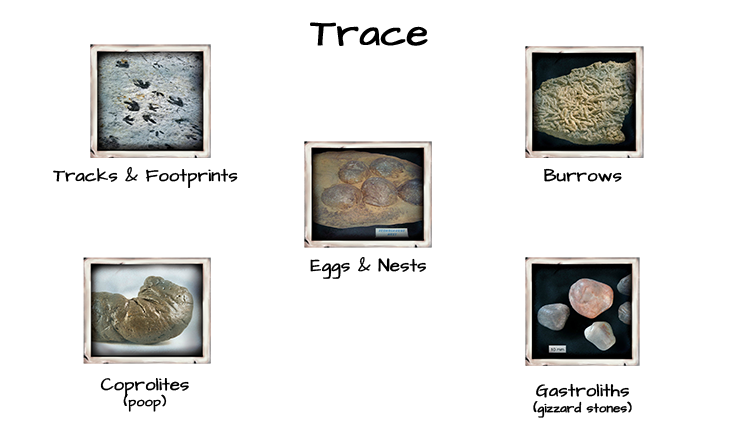Grade Level
4-8
minutes
15 minutes or fewer
subject
Earth Science
stem practices
Obtaining, Evaluating, and Communicating Information
Activity Type:
group game, fossils

Though you may be the most familiar with fossils that look like the Triceratops above, there are many different types of fossils that result from a variety of different forms of preservation. Fossils are the remains or traces of organisms that lived 10,000 years ago or longer. Organisms that die rarely leave behind bones that fossilize. Instead, when an animal dies in nature, its body is quickly pulled apart by vultures and other scavengers, big and small. Decomposers like bacteria, fungi, and insects, and physical factors such as water, wind, and sunlight, further break down the body, leaving few remains.
Occasionally, parts of a dead organism escape decay. If the right conditions exist, then parts of a dead animal can be fossilized before they decay completely. In this activity, you will learn about different types of fossilization, and then apply your knowledge to play the Fossilize Me! card game.
Meet Fiona, The Pregnant Ichthyosaur Fossil
Fossil Types
Fossils can be divided into body fossils, which entail whole organisms or body parts, and trace fossils, which preserve evidence of an organism’s activities or behaviors. Examples of trace fossils include footprints, nests, eggs, worm burrows, gizzard stones, and even poop!

Body fossils preserve a piece of the organism’s anatomy and can be further separated based on the condition of that preservation.
Sometimes, the remains of an organism are preserved in a virtually unaltered state, meaning that the original composition of the organism is largely intact. Materials such as ice, volcanic ash, amber, asphalt, peat bog, and lake sediment can preserve remains in this way.

Most of the time, however, remains become altered through environmental exposure and decay. There are several types of fossilization processes that can alter an organism’s remains.

In the case of petrification, minerals seep into the remains of an organism and crystallize over long stretches of time, forming a stone version of the original organism.
Carbonization is like making a “carbon copy” of an organism. The carbon contained within the remains of a soft-bodied animal or plant forms a stamp-like impression on the sediment, while the remaining molecules break down.

A mold fossil forms when the remains of an organism leave a mark in sediment that hardens before the organism rots or is washed away. Sediment can then fill in that mold, forming what looks like a sand or clay version of the organism; this is called a cast fossil. (Molds and casts may sound like trace fossils, but they are considered body fossils because they preserve an aspect of an organism’s anatomy rather than its activity.)
Want to test your knowledge of fossils? Take the “What’s your type?” quiz.
Meet Lokiceratops, A Giant Dinosaur With Blade-Like Horns
Let's Play Fossilize Me!
Now that you’ve learned about different fossil types, you can play Fossilize Me! In this game you are creating fossils by matching them with the correct fossilization process and the resulting fossil. Use your knowledge of different types of fossils to help you decide your matches.
Game objective
The goal is to make as many proper trios as possible. A trio must include three cards that work to create a specific fossil: Organism + Fossilization Process + Fossil
The game ends when one of the players gets rid of all of their cards.
Players: 2-4 (A single player can also play by making trios and checking them with the answer sheet.)
Fossilize Me! Cards
- 12 Fossil cards
- 12 Organism cards
- 17 Fossilization Process cards (5 Unaltered, 3 Trace, 3 Mold, 3 Cast, 3 Carbonization)
- 4 Decay Before Burial cards
You can print the Fossilize Me! Cards on any business card template that is Avery 8871 compatible and allows for double-sided printing. They will also print on letter-sized printer paper. We recommend using a color printer.
Rules & Game Play
Before starting the game, players should familiarize themselves with the five different fossilization processes featured: unaltered, carbonization, cast, mold, trace by reading the fossil information in this resource.
The cards are shuffled, and each player is dealt seven cards. The rest are placed face down on the table in a draw pile.
To begin the game, each player must lay down an Organism card. You can put down as many Organism cards as you were dealt, and you should place each of them face up in front of you. There is no particular order here—all players can play their organism cards at the same time. If you notice that you were dealt a trio, you can play the trio (or trios) instead of just the Organism card. These Organism cards and trios should remain on the table in front of you as the game continues.
If you notice a mistake in another player’s trio (e.g., an Organism card does not match the Fossilization Process and Fossil cards), you can fix it and keep the trio for yourself. You can also fix your own trio if you notice the mistake before anyone else.
If you don’t have an Organism card, you must take a card from the draw pile each time it’s your turn, until you eventually draw an Organism card to use as an opener.
Continuation of play
After players have put down any Organism cards/trios they have, the objective is to make as many more trios as possible. The youngest player goes first. You must always carry out a play when it’s your turn.
When it’s your turn, you can make one or two of the following plays, but you MUST make at least one:
- Take a card from the draw pile.
- Place a card, facing up, on a discard pile next to the draw pile.
- Complete a trio by playing the appropriate Fossilization Process + Fossil cards after an Organism card has just been played. The trio then belongs to you, and goes to your side of the table.
- Block an opponent’s trio by playing a Decay Before Burial card. (See the section below on how to use these cards.)
Players can never have more than seven cards in their hand. If you have seven cards and no option but to take a card from the draw pile, you must put one card in the discard pile, before or after drawing.
At any time (even out of turn), any player can take the top card from the discard pile to complete a trio. The trio must be played immediately.
The game continues, with players forming as many trios as possible.
If the draw pile runs out of cards, turn the discard pile over to become the draw pile.
Decay Before Burial card
There are four Decay Before Burial cards. These can be used to “block” a trio from being completed. For example, if one player discards an Organism card, the next player can lay down a Decay Before Burial card, thus preventing any other players from completing a trio.
In real life, if an organism decays before being buried, it will not form a fossil. The Decay Before Burial card symbolizes this fact.
You must carefully consider when to put down a Decay Before Burial card, because you might later end up drawing the Fossilization Process and Fossil cards that complete the trio.
Winning the Game
The game ends when someone runs out of cards. The trios are then counted, and whoever has the most trios wins.
An answer sheet of trios is provided with the game. This sheet should only be consulted at the end of the game when the trios are being checked and counted. If you formed an incorrect trio, that one is not counted as part of your score.
Educator's Toolbox
Meet the Writer
About Marta Toran
@mtoranMarta Toran is a former middle and high school science teacher and serves as a K–12 STEM outreach coordinator at Appalachian State University in North Carolina. Her daily goal is to bring excitement about science to as many rural classrooms as possible. She can often be spied hauling rocks or dollar-store finds for use in science projects and exhibits.

